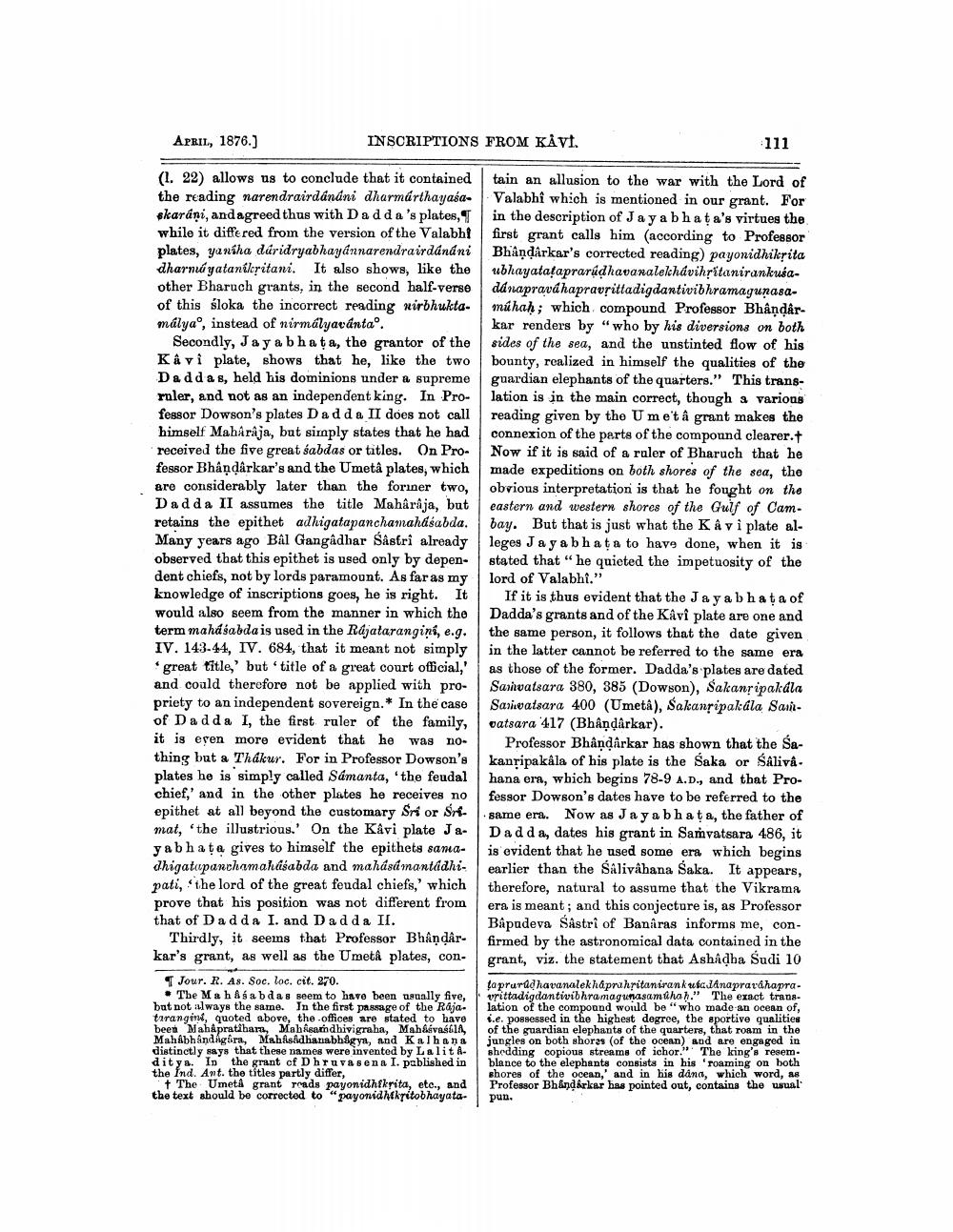________________
APRIL, 1876.]
INSCRIPTIONS FROM KAVİ.
tain an allusion to the war with the Lord of Valabhi which is mentioned in our grant. For in the description of Ja ya bhata's virtues the first grant calls him (according to Professor Bhandarkar's corrected reading) payonidhikrita ubhayataṭaprarudhavanalekhávihṛitanirankusa
(1. 22) allows us to conclude that it contained the reading narendrairdánáni dharmarthayasaskarani, and agreed thus with Dadd a 's plates, T while it differed from the version of the Valabhi plates, yaniha dúridryabhayannarendrairdánáni dharmayatanikritani. It also shows, like the other Bharuch grants, in the second half-verse dánapravahapravṛittadigdantivibhramagunasaof this sloka the incorrect reading nirbhukta- muhah; which compound Professor Bhandarmálya, instead of nirmalyavánta. kar renders by "who by his diversions on both sides of the sea, and the unstinted flow of his bounty, realized in himself the qualities of the guardian elephants of the quarters." This translation is in the main correct, though a various reading given by the Um e't â grant makes the connexion of the parts of the compound clearer.+ Now if it is said of a ruler of Bharuch that he made expeditions on both shores of the sea, the obvious interpretation is that he fought on the eastern and western shores of the Gulf of Cambay. But that is just what the K â v i plate alleges Jayabhata to have done, when it is stated that "he quieted the impetuosity of the lord of Valabhi."
Secondly, Jay a bha ta, the grantor of the Kavi plate, shows that he, like the two Daddas, held his dominions under a supreme ruler, and not as an independent king. In Professor Dowson's plates Dad da II does not call himself Maharaja, but simply states that he had received the five great sabdas or titles. On Professor Bhandarkar's and the Umetâ plates, which are considerably later than the former two, Dadda II assumes the title Mahârâja, but retains the epithet adhigatapanchamaháśabda. Many years ago Bal Gangadhar Sâstri already observed that this epithet is used only by dependent chiefs, not by lords paramount. As far as my knowledge of inscriptions goes, he is right. It would also seem from the manner in which the term maháśabda is used in the Rajatarangini, e.g. IV. 143-44, IV. 684, that it meant not simply 'great title,' but 'title of a great court official,' and could therefore not be applied with propriety to an independent sovereign.* In the case of Dadda I, the first ruler of the family, it is even more evident that he was nothing but a Thakur. For in Professor Dowson's plates he is simply called Samanta, 'the feudal chief,' and in the other plates he receives no epithet at all beyond the customary Sri or Srimat, the illustrious.' On the Kâvi plate Jayabhata gives to himself the epithets samadhigatapanchamahúsabda and mahásámantádhipati, the lord of the great feudal chiefs,' which prove that his position was not different from that of Dadda I. and Dadda II.
Thirdly, it seems that Professor Bhandarkar's grant, as well as the Umetâ plates, con
Jour. R. As. Soc. loc. cit. 270.
The Mahasabdas seem to have been usually five, but not always the same. In the first passage of the Raja. tarangini, quoted above, the offices are stated to have been Mahapratihara, Mahasamdhivigraha, Maháávaśúla, Mahabhandagira, Mahâsâdhanabhagya, and Kalhana distinctly says that these names were invented by Lalita ditya. In the grant of Dhruva sena I. pablished in the Ind. Ant. the titles partly differ,
The Umetâ grant reads payonidhikrita, etc., and the text should be corrected to "payonidhikritobhayata
111
If it is thus evident that the Jay a bhata of Dadda's grants and of the Kâvi plate are one and the same person, it follows that the date given in the latter cannot be referred to the same era as those of the former. Dadda's plates are dated Samvatsara 380, 385 (Dowson), Sakanṛipakála Samvatsara 400 (Umetâ), Sakanṛipakála Samvatsara 417 (Bhandarkar).
Professor Bhandarkar has shown that the Sakanṛipakåla of his plate is the Saka or Śâlivâhana era, which begins 78-9 A.D., and that Professor Dowson's dates have to be referred to the same era. Now as Jayabhata, the father of Dadda, dates his grant in Samvatsara 486, it is evident that he used some era which begins earlier than the Salivahana Šaka. It appears, therefore, natural to assume that the Vikrama era is meant; and this conjecture is, as Professor Bâpudeva Śâstri of Banâras informs me, confirmed by the astronomical data contained in the grant, viz. the statement that Ashadha Sudi 10
tapraradhavanalekhaprahritanirankuta dánapravahapravrittadigdantivibhramagunasamahaḥ." The exact translation of the compound would be "who made an ocean of, i.e. possessed in the highest degree, the sportive qualities of the guardian elephants of the quarters, that roam in the jungles on both shores (of the ocean) and are engaged in shedding copious streams of ichor." The king's resem. blance to the elephants consists in his 'roaming on both shores of the ocean,' and in his dána, which word, as Professor Bhandarkar has pointed out, contains the usual pun.




